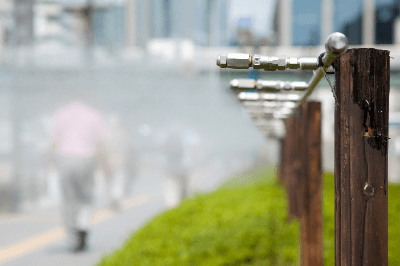What Is Mist Equipment?
 Mist equipment is a device that sprays water in a mist-like spray over a wide area, used for cooling and fire extinguishing equipment to prevent outdoor temperatures from rising.
Mist equipment is a device that sprays water in a mist-like spray over a wide area, used for cooling and fire extinguishing equipment to prevent outdoor temperatures from rising.
Mist equipment can lower outdoor temperatures by 2 to 3 degrees Celsius. Mist equipment pressurizes water and sprays it into the air, so it becomes a dry mist that does not get wet against the skin and causes no discomfort.
Like the sprinkling effect, the ambient outside temperature is lowered by utilizing the vaporization heat phenomenon, which takes away the heat when water evaporates. When used for cooling, this device is good for the environment because it does not require an outdoor unit like air conditioners, etc., and does not release heat outside.
The shape of the mist nozzle and the mist pump vary, and so do the characteristics of mist equipment. Mist equipment can be used more effectively by selecting the appropriate mist equipment according to the purpose of use.
Uses of Mist Equipments
Mist equipment has the effect of reducing the rise in temperature and can create partially cooler areas outdoors. For this reason, they are used outdoors and in places where large numbers of people are expected to gather, such as large facilities, for the purpose of preventing heat stroke.
It is also used for disinfecting and cleaning livestock farms and waste disposal facilities by spraying disinfectants and chemicals in mist form. Furthermore, it is also used for the purpose of preventing the inhalation of fine dust into the body by incorporating it into the molecules of water, and for maintaining a constant humidity level through its humidifying effect. Mists are also used by the entertainment industry to create dramatic effects.
Principle of Mist Equipment
The cooling effect of mist equipment is based on the principle of heat of vaporization.
Heat of vaporization is the heat that water absorbs from its surroundings in order to evaporate, thus absorbing heat from the surroundings and lowering the temperature.
The system consists of a pump, nozzles, and water supply pipes. The pump applies high pressure to the water taken in from the water supply pipes and pushes it out through the nozzles, which have a small diameter, to generate a fine mist. The fine mist is easily vaporized and produces a dry mist that does not get wet to the touch.
Structure of Mist Equipment
Mist equipment consists of the following seven components:
1. Mist Pump
The mist pump is the heart of mist equipment. Water pressurized by the pump is pushed out through the mist nozzle, which has a very small jet diameter, to generate a fine mist. A higher pressure will produce finer water particles and a greater number of particles.
When a high-pressure pump that pressurizes to nearly 7 MPa is used, the majority of the mist particles are 5 microns or smaller, resulting in a dry mist. By the time the mist falls to the ground or floor, it evaporates in the atmosphere, and the heat of vaporization at that time pulls down the ambient temperature.
2. Mist Nozzle
Mist nozzles are used to mix water pressurized by a mist pump with atmospheric air to atomize it and spray it. Mist nozzles differ in the diameter of the atomizing port. The smaller the atomizing port, the finer the mist particles, the easier they vaporize, and the less water is required to atomize the mist.
3. Water Supply Pipe
It serves as a passageway for water taken from the water source to be sent to the mist pump.
4. Filter
Install a filter in the water supply pipe to prevent foreign matter or calcium from clogging the mist pump.
5. Drain
This is used to drain water that is retained in the water supply pipe after the Mist equipment has stopped operating. It is installed in the water supply pipe in front of the mist pump to prevent water droplets from falling and to prevent the mist nozzle from clogging due to calcium in the water after the pump has stopped operating. There are mechanical drains and electric drains. Electric drains relieve pressure in the piping and drain water more quickly, thus preventing water droplets from falling from the mist nozzles.
6. Mist Fan
Mist fans increase the time mist drifts in the atmosphere and accelerates vaporization. The effect of the mist can be applied to a wider area.
7. Water Source
A water source is required to supply the pump. If a water tank is used, install a pump capable of supplying the required flow rate.
8. Power Supply
Power must be supplied to run the mist pump. A power supply with sufficient electrical capacity for the pump used should be selected.